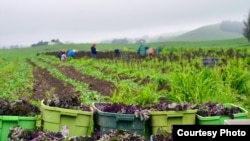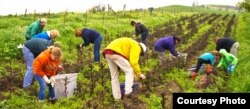SONOMA COUNTY, CALIFORNIA —
One third of all food fails to make it from farm to table, according to the United Nations. But one farm in California has turned to social media to try to reduce wasted produce.
Bloomfield Farms general manager Nick Papadopoulos grew increasingly frustrated as he watched his employees repeatedly return from a weekend’s worth of farmer’s markets with unsold, top quality produce that would spoil before the next market day.
Workers would leave the extra produce in a barn where Papadopoulos would find boxes of leafy greens, herbs and carrots piled onto wooden pallets.
Social media experiment
So he came up with a plan to offer the food at a deep discount and he spread the word by updating the farm’s Facebook status on Sunday nights. The deals were open to anyone on the social media site. One week, the vegetables were snapped up by a group of homeowners in a neighboring community. Another week, a group of friends went in on it.
Berry Smith Salinas, who lives nearby and owns a local gourmet food business, takes advantage of those sales by loading up on the leftover organic vegetables and herbs
“This morning I woke up to all these Facebook messages and people cross posting that there was a load of produce that hadn’t been picked up," she said.
As she tied the boxes down under a tarp, Salinas got a stream of messages from friends who were planning to gather at her commercial kitchen that night to claim their portions.
Food waste
This experiment in social media marketing began when Papadopoulos took a break from his job as a business consultant and went to work at his father-in-law’s farm.
He was struck by the problem of wasted food when, on short notice and with limited time, he couldn’t find a place to donate 32 cases of organic broccoli. They ended up in the compost bin and chicken coop.
“I don’t believe we should let it go to waste," he said. "I believe we should share it, donate it, whatever it takes. And if possible, as farmers, we would like to recover a small portion of our costs.”
The latest farm census from the United States Department of Agriculture found that more than half of the small farms in California do not turn a profit. Encouraged by the success of his Facebook posts, Papadopoulos recruited a local Web team to create a site, cropmobster.com, where people involved with food production, hunger relief and those who want to buy local can access surplus produce.
Crop mobster
The website went online in March, and since then, non-profits, restaurants and individuals have salvaged more than 20,000 kilos of food.
A recent study found that, depending on weather and demand, up to 30 percent of fresh crops grown in the U.S. don’t make it to market. Crop mobster addresses one of the main problems with surplus produce.
“And that is that it’s often spontaneous, it’s inconsistent, and it’s hard for anyone to really build a business off this," said Dana Gunders, who researches food waste for the National Resources Defense Council. "So the way the technology can enable this more organic solution is really powerful.”
Apps and websites that connect large farms with food banks are also emerging. And a company based in San Francisco is working with a grocery chain to cheaply market perfectly good produce that doesn’t meet the size and quality standards for sale in a U.S. supermarket…say an apple that is 37, rather than 40 percent red.
But will these efforts work? Remember Berry Salinas who picked up the vegetables from Bloomfield Farms? A few days later, she was in her kitchen, sauteeing the very last carrots, potatoes and collards from the haul.
Salinas said within two days, the vegetables were either distributed to friends who had bought a portion, or donated to a local nonprofit. She pointed to a bag of carrot peels and a few stalks from greens on her counter.
“The remains of two pallets of veggies reduced," she said, "to maybe two pounds."
Bloomfield Farms’ Nick Papadopoulos hopes this becomes commonplace. He says gleaning food from farms is a centuries old tradition, but it’s time to do it with 21st Century tools.
Bloomfield Farms general manager Nick Papadopoulos grew increasingly frustrated as he watched his employees repeatedly return from a weekend’s worth of farmer’s markets with unsold, top quality produce that would spoil before the next market day.
Workers would leave the extra produce in a barn where Papadopoulos would find boxes of leafy greens, herbs and carrots piled onto wooden pallets.
Social media experiment
So he came up with a plan to offer the food at a deep discount and he spread the word by updating the farm’s Facebook status on Sunday nights. The deals were open to anyone on the social media site. One week, the vegetables were snapped up by a group of homeowners in a neighboring community. Another week, a group of friends went in on it.
Berry Smith Salinas, who lives nearby and owns a local gourmet food business, takes advantage of those sales by loading up on the leftover organic vegetables and herbs
“This morning I woke up to all these Facebook messages and people cross posting that there was a load of produce that hadn’t been picked up," she said.
As she tied the boxes down under a tarp, Salinas got a stream of messages from friends who were planning to gather at her commercial kitchen that night to claim their portions.
Food waste
This experiment in social media marketing began when Papadopoulos took a break from his job as a business consultant and went to work at his father-in-law’s farm.
He was struck by the problem of wasted food when, on short notice and with limited time, he couldn’t find a place to donate 32 cases of organic broccoli. They ended up in the compost bin and chicken coop.
“I don’t believe we should let it go to waste," he said. "I believe we should share it, donate it, whatever it takes. And if possible, as farmers, we would like to recover a small portion of our costs.”
The latest farm census from the United States Department of Agriculture found that more than half of the small farms in California do not turn a profit. Encouraged by the success of his Facebook posts, Papadopoulos recruited a local Web team to create a site, cropmobster.com, where people involved with food production, hunger relief and those who want to buy local can access surplus produce.
Crop mobster
The website went online in March, and since then, non-profits, restaurants and individuals have salvaged more than 20,000 kilos of food.
A recent study found that, depending on weather and demand, up to 30 percent of fresh crops grown in the U.S. don’t make it to market. Crop mobster addresses one of the main problems with surplus produce.
“And that is that it’s often spontaneous, it’s inconsistent, and it’s hard for anyone to really build a business off this," said Dana Gunders, who researches food waste for the National Resources Defense Council. "So the way the technology can enable this more organic solution is really powerful.”
Apps and websites that connect large farms with food banks are also emerging. And a company based in San Francisco is working with a grocery chain to cheaply market perfectly good produce that doesn’t meet the size and quality standards for sale in a U.S. supermarket…say an apple that is 37, rather than 40 percent red.
But will these efforts work? Remember Berry Salinas who picked up the vegetables from Bloomfield Farms? A few days later, she was in her kitchen, sauteeing the very last carrots, potatoes and collards from the haul.
Salinas said within two days, the vegetables were either distributed to friends who had bought a portion, or donated to a local nonprofit. She pointed to a bag of carrot peels and a few stalks from greens on her counter.
“The remains of two pallets of veggies reduced," she said, "to maybe two pounds."
Bloomfield Farms’ Nick Papadopoulos hopes this becomes commonplace. He says gleaning food from farms is a centuries old tradition, but it’s time to do it with 21st Century tools.











